
Oct 31, 2016 Open virtualbox and click ‘New’ to create a new virtual machine with the following details: Name: El Capitan. Version: Mac OS X 10.11 El Capitan (64 bit) Click next, select 4GB of RAM, and next again. Select the El Capitan image that you have downloaded and unzipped as the disk image, and create the machine.
How to create an OS X El Capitan VM that will run on Linux. VirtualBox only officially supports OS X guests on an OS X host, but it is possible to create one on an OS X host and transfer it over to a Linux host. This tutorial will go over one possible way to accomplish this task. What you will need. An Apple computer running OS X 10.11. Mac Os X El Capitan Virtualbox Image Download Virtualbox. Installing Mac OS X El Capitan on PC using VirtualBox will break some sweat. But considering the usability of the OS, it is worth the time. In case you encounter problems following this guide, feel free to use the comment sections.
I have a MacBook Pro mid 2009 17' running El Capitan.
I've been running VB successfully with a wide variety of guest OS's for years.
Now, I did the last VB 6.0.4 update (from VB 5.2.12 to 6.0.4) as usual. I had not checked the Docu whether El Capitan is still belongs to the supported Mac Host operating systems, before I did the update.. So any of my guest OS's (Solaris 10, Linux) run for about a week without problems.
VirtualBox only officially supports OS X guests on an OS X host, but it is possible to create one on an OS X host and transfer it over to a Linux host. This tutorial will go over one possible way to accomplish this task.
What you will need
- An Apple computer running OS X 10.11
- A Linux computer to transfer the VM over to
- 20 GB free on the Apple Machine
- 40 GB free on the Linux Machine
Step One: VMWare
Install VMWare Fusion Pro on your OSX Host ( https://www.vmware.com/products/fusion/fusion-evaluation ). Open it up and select File -> New.

On the 'Select the Installation Method' menu, choose 'Install OSX from the recovery partition'. Follow the instructions and soon OSX will start installing in a VMWare VM. Go through the OSX installation process until the point where OSX asks you to setup the installation (IE: create users, etc). This could take up to two hours. When its done, shutdown the VMWare VM.
In the VMWare 'Virtual Machine Library' menu, select the OSX VM you just created, and then select File -> Export To OVF.
Cape coast font. This will create a folder with three files in it:
- .mf
- .ovf
- .vmdk
Step Two: Modify the OVF Files
Vray 3.6 sketchup download. Next we need to take care of a few inconsistencies between VMWare's OVF format and VirtualBox's OVF format. Run the following commands on the .ovf file:
El Capitan Os X Download
Since we have modified the OVF file, its SHA1 checksum will have changed. We need to update the .mf file to account for these changes. The .mf file should look something like this:
Run: Nallathoru kudumbam tamil mp3 songs download.
Take the resulting hash and replace the hash after SHA1(<VM_NAME>.ovf)= in <VM_NAME>.mf with this result.

Copy the OVF folder with all three files over to the Linux Machine.
Step Three: Import OVF into Linux host VirtualBox
Os X El Capitan Virtualbox Image Download
Open up virtualbox on the Linux host, and import the OVF. You'll need to set the VM OS Type to 'Mac OS X' and the OS Version to 'Mac OS X 10.11 El-capitan (64-bit)'.
Next, open up a terminal and run the following VBoxManage commands:

Mac Os X El Capitan Virtualbox
Now you should be able to boot up the VM and have it run properly on the Linux host.